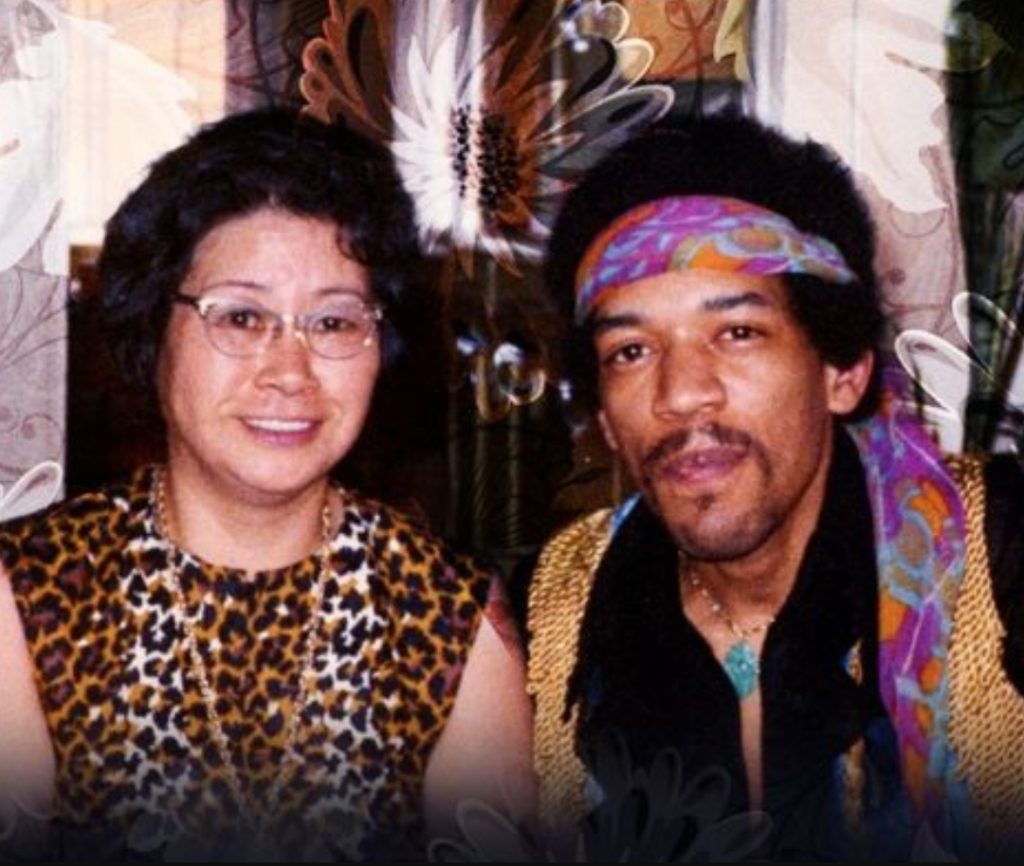Ayako “June” Fujita Hendrix (1920–1999) was the stepmother of legendary guitarist Jimi Hendrix and a significant figure in his family life. Born in Puyallup, Washington, she spent part of her childhood in Japan before returning to the U.S. at age 22. During World War II, she was interned at the Minidoka Relocation Center in Idaho, a camp for Japanese Americans. After the war, she worked as a dry cleaner’s tailor and presser, and later as a housekeeper.
In 1966, she married James “Al” Hendrix, Jimi’s father, and became a mother figure to Jimi and his siblings. She also persuaded Al to adopt her youngest child, Janie Jinka (later known as Janie Hendrix), who would become Jimi’s step-sister and later the steward of his legacy.
Ayako was known for her warmth and dedication to her family. She was adept at cooking both traditional Japanese dishes and African American soul food, and she enjoyed sewing and crocheting clothes for her family. Her relationship with Jimi was close and affectionate; Jimi was particularly pleased to have a younger step-sister in Janie .
Ayako passed away from cancer on August 20, 1999, at the age of 79. She was interred next to Jimi at Greenwood Memorial Park in Renton, Washington.
Early Life and Background
Birth and Parentage
Ayako was the daughter of Kimiko Shimamura and Kumaichi Fujita. Her early years were spent in Puyallup, Washington, before she moved to Japan at the age of seven to live with her grandparents and attend school. This transpacific upbringing exposed her to both Japanese and American cultures, shaping her identity and worldview.
World War II Internment
During World War II, Ayako, along with thousands of other Japanese Americans, was forcibly relocated to the Minidoka Relocation Center in Idaho. These internment camps were established by the U.S. government under Executive Order 9066, which authorized the internment of Japanese Americans due to wartime hysteria and racial prejudice. Ayako’s experiences in the camp were marked by hardship and resilience, reflecting the broader struggles faced by Japanese Americans during this period.
Personal Life and Family
Marriage to James Allen “Al” Hendrix
In 1966, Ayako married James Allen “Al” Hendrix, the father of Jimi Hendrix. Their union blended their families, with Ayako bringing her daughter Janie into the household. Al adopted Janie, solidifying their familial bond. Ayako’s relationship with Jimi was characterized by warmth and affection, despite the complexities of their blended family dynamics.
Role as Stepmother
Ayako embraced her role as a stepmother with dedication and love. She worked diligently to create a nurturing home environment, balancing traditional Japanese customs with the cultural nuances of her new family. Her efforts were instrumental in fostering a sense of unity and belonging among her children.
Read Also: Emil Bove Wikipedia, Biography, Age, Net Worth, Wife, Career, Family
Career and Contributions
Professional Life
Outside her family responsibilities, Ayako contributed to her community through various roles. She worked as a tailor and presser at a dry cleaner’s, showcasing her skills and work ethic. Later, she served as a housekeeper, roles that reflected her commitment to hard work and service.
Cultural Influence
Ayako’s cultural heritage played a significant role in her family’s life. She introduced traditional Japanese cuisine and customs to her household, enriching their cultural tapestry. Her ability to blend Japanese and African American traditions created a unique cultural fusion that influenced her family’s identity.
Later Years and Legacy
Health Challenges and Passing
In her later years, Ayako faced health challenges, including a stroke in 1980. Despite these setbacks, she remained active and engaged with her family. Ayako passed away on August 20, 1999, at the age of 79, leaving behind a legacy of resilience, love, and cultural integration.
Influence on Jimi Hendrix’s Legacy
While Ayako’s direct involvement in Jimi Hendrix’s musical career was limited, her influence on his family life was profound. Her role as a mother figure to Jimi and her efforts in managing the family dynamic contributed to the stability and support that allowed Jimi to focus on his music.
Conclusion
Ayako June Hendrix’s life story is a testament to the strength and resilience of individuals who navigate complex cultural landscapes and familial roles. Her experiences as a Japanese American during World War II, her integration into the Hendrix family, and her contributions to her community reflect a multifaceted individual whose impact extends beyond her association with a famous stepson. Her legacy continues to inspire those who value cultural understanding, familial devotion, and personal strength.
FAQs
What was Ayako June Hendrix’s birth name?
She was born as Ayako Fujita.
Where was Ayako born?
Ayako was born in Puyallup, Washington, USA.
Who were Ayako’s parents?
Her parents were Kimiko Shimamura and Kumaichi Fujita.
Did Ayako have any children?
Yes, Ayako had a daughter named Janie, whom she brought into her marriage with Al Hendrix.
What was Ayako’s role in Jimi Hendrix’s life?
Ayako served as Jimi Hendrix’s stepmother, providing a nurturing and supportive environment for him and his siblings.
Did Ayako have any siblings?
Yes, Ayako had siblings, including Kaname and Yoshio Fujita.
What was Ayako’s occupation?
Ayako worked as a tailor and presser at a dry cleaner’s and later as a housekeeper.
Was Ayako involved in the music industry?
While Ayako was not directly involved in the music industry, she played a significant role in managing the Hendrix family’s affairs, allowing Jimi to focus on his music.
When did Ayako pass away?
Ayako passed away on August 20, 1999, at the age of 79.
Where is Ayako buried?
Ayako is buried at Greenwood Memorial Park in Renton, Washington, alongside her husband, Al Hendrix.
